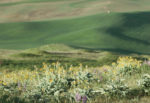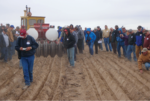Advertise Follow Us
Items Tagged with 'Pacific Northwest'
ARTICLES
No-Tillers Ready To Cash In On Certification
This program will recognize no-tillers that adopt economically viable, sustainable practices to protect the environment and add value to their grain crops.
Read More
New Concepts For Deep-Furrow Drills May Boost Dryland Conservation
Research in the Pacific Northwest finds new packer wheels, coulters, spider wheels and wider row spacings could help wheat farmers embrace conservation tillage without sacrificing yields.
Read More
Bringing No-Till To The Palouse
From evaluating rotations and chemical options to designing the first successful no-till drill, Guy and Mort Swanson helped no-till take root in the Pacific Northwest.
Read More
Do More With Direct-Seeding And Limited Moisture
Thanks to direct seeding, Washington landowners spend more dollars, but end up with higher returns.
Read More
Try These Proven Residue-Management Tricks
Regardless of where you farm or the crops you grow, study these solid residue management lessons from no-tillers growing high-yielding grain crops.
Read More
Diseases Travel Over "Green Bridge" To Quietly Steal No-Till Yields
Pathogens feed on dying plants then live long enough to prey on newly planted crops1
Read More
Large Farm Operation Finds No-Till A Path To Lasting Success
The move away from conventional tillage stopped erosion and saved the soil for the future while widening the window of opportunity for timely seeding.
Read More
Stretch Your Rotations To Make No-Till Even More Effective
This concept pays in more ways than one for no-tillers with livestock.
Read More












